MaryAnn Bernal's Blog, page 252
August 2, 2014
History Trivia - veni, vidi, vici
August 2
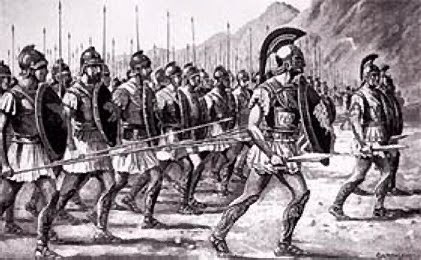
338 BC A Macedonian army led by Philip II defeated the combined forces of Athens and Thebes in the Battle of Chaeronea, securing Macedonian hegemony in Greece and the Aegean.
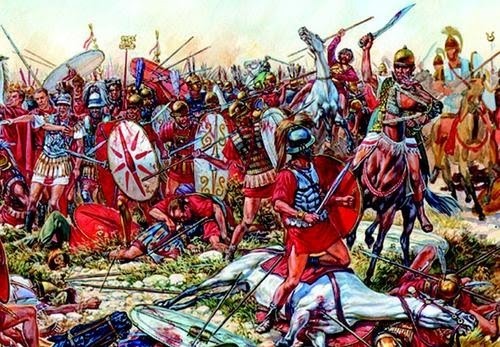
216 BC Second Punic War: Battle of Cannae – The Carthaginian army lead by Hannibal and his elephants defeated a numerically superior Roman army under command of consuls Lucius Aemilius Paullus and Gaius Terentius Varro, killing 60,000.

47 BC Julius Caesar said "veni, vidi, vici" (I came, I saw, I conquered) after defeating Pharnaces, King of Pontus (northeast Turkey).

924 Aelfweard of Wessex, second son of Edward the Elder (son and heir of Alfred the Great) died.

1100 William II (Rufus) was killed by an arrow shot by Walter Tyrell while hunting in the New Forest.


338 BC A Macedonian army led by Philip II defeated the combined forces of Athens and Thebes in the Battle of Chaeronea, securing Macedonian hegemony in Greece and the Aegean.

216 BC Second Punic War: Battle of Cannae – The Carthaginian army lead by Hannibal and his elephants defeated a numerically superior Roman army under command of consuls Lucius Aemilius Paullus and Gaius Terentius Varro, killing 60,000.

47 BC Julius Caesar said "veni, vidi, vici" (I came, I saw, I conquered) after defeating Pharnaces, King of Pontus (northeast Turkey).

924 Aelfweard of Wessex, second son of Edward the Elder (son and heir of Alfred the Great) died.

1100 William II (Rufus) was killed by an arrow shot by Walter Tyrell while hunting in the New Forest.

Published on August 02, 2014 04:58
August 1, 2014
History Trivia - "Rule Britannia" performed for the first time.
August 1

1096 The crusaders under Peter the Hermit reached Constantinople.

1137 Louis VI, the Fat, King of France died of dysentery.

1203 Isaac II Angelus, restored Eastern Roman Emperor, declared his son Alexius IV Angelus co-emperor after pressure from the forces of the Fourth Crusade.

1740 "Rule Britannia," which was written by Thomas Arne, was performed for the first time.


1096 The crusaders under Peter the Hermit reached Constantinople.

1137 Louis VI, the Fat, King of France died of dysentery.

1203 Isaac II Angelus, restored Eastern Roman Emperor, declared his son Alexius IV Angelus co-emperor after pressure from the forces of the Fourth Crusade.

1740 "Rule Britannia," which was written by Thomas Arne, was performed for the first time.

Published on August 01, 2014 05:06
July 31, 2014
Warriors' Bones Reveal Bizarre Iron Age Rituals
By Stephanie Pappas
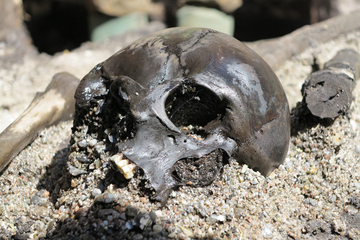
 A skull of an Iron Age warrior discovered in a bog in Denmark shows signs of battle.
A skull of an Iron Age warrior discovered in a bog in Denmark shows signs of battle.
Credit: Ejvind Hertz, Skanderborg Museum
The bones of dozens of Iron Age warriors found in Denmark were collected and ritually mutilated after spending months on the battlefield, archaeologists say.
At least six months after the soldiers died, their bones were collected, scraped of remaining flesh, sorted and dumped in a lake. Some were handled in a truly bizarre manner; for instance, four pelvises were found strung on a stick.
"We think it's a kind of ritual closure of the war," said Mads Kähler Holst, project manager at the dig and head of the department of archaeology at the Moesgård Museum in Denmark. The victors seem to have carried out their gruesome work on a spit of land extending into the lake where the bones were dumped, the researchers said
Bog bodies
The site of the boneyard is in East Jutland, in a wetland area known as Alken Enge. Drainage work and peat digging have been turning up ancient human remains in this bog for decades, Holst told Live Science.
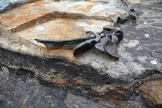
[image error] Four pelvises strung on a stick were found at Alken Enge in Denmark.
Four pelvises strung on a stick were found at Alken Enge in Denmark.
Credit: Peter Jensen, Aarhus Universitet
View full size imageFormal excavation of the site finds it to be a mass grave dating back about 2,000 years, to the transition from B.C. to A.D. At the time, the area was about 186 miles (300 kilometers) north of the farthest reach of the Roman Empire, Holst said, and would have been occupied by Germanic tribes.
Archaeologists have turned up at least 60 skeletonsor parts of skeletons in what used to be the bed of Lake Mossø at the site. The lake still exists, but it's smaller than it was 2,000 years ago. The 60 catalogued remains don't include bones found previously — or the many more skeletons archaeologists expect to discover.
"We have trenches going through different areas, so we know we are only touching on a small part of what is actually there," Holst said.
Most of the bones are found disarticulated from one another, and many bear the marks of the battlefield: trauma from swords, spears and axes. Spearheads, an ax, the tip of a sword and shields have also been found at the site, Holst said. All of the bodies are male.
Macabre ritual
All of the evidence points to a straightforward defeat in battle. But the bones also bear strange marks of tampering after the soldiers' death.
First, many have been gnawed by animals, including large predators such as wolves, dogs and badgers, Holst said. The species present and amount of scavenging suggest the bodies stayed out in the open for at least six months to a year, he said.
After this time, someone collected the corpses and sorted at least some of the bones by type. Marks of cutting and scraping suggest the bones were separated deliberately, and that they had any remaining flesh removed. Animal sacrifices and ceramic pots mixed in with the remains suggest some sort of religious ritual, Holst said. Along with the pelvises strung like beads on a stick, there is evidence that leg bones and thighbones were sorted, too, he said.
From a land spit extending into what was then the lake, the ancient people conducted these rituals and then dumped the bones. Holst and his colleagues know nothing for sure about the victors and the slaughtered, but they suspect that the winners had a geographical attachment to the area, given that they were around long enough to conduct these rituals. There are examples of ritual treatment of defeated enemies in what is now France, Switzerland and England in the centuries prior to this find, Holst said, but nothing like it has ever been seen in Denmark or the surrounding areas.
The delay in disposing of the bodies could have been part of the ritual, Holst said. Or, perhaps the battle was part of a longer war, and the winners did not return to the bones until the conflict was over, Holst added.
The findings were announced July 28 by Aarhus University. This season's excavation at the site will continue until Aug. 8
.http://www.livescience.com/47124-warr...


 A skull of an Iron Age warrior discovered in a bog in Denmark shows signs of battle.
A skull of an Iron Age warrior discovered in a bog in Denmark shows signs of battle.Credit: Ejvind Hertz, Skanderborg Museum
The bones of dozens of Iron Age warriors found in Denmark were collected and ritually mutilated after spending months on the battlefield, archaeologists say.
At least six months after the soldiers died, their bones were collected, scraped of remaining flesh, sorted and dumped in a lake. Some were handled in a truly bizarre manner; for instance, four pelvises were found strung on a stick.
"We think it's a kind of ritual closure of the war," said Mads Kähler Holst, project manager at the dig and head of the department of archaeology at the Moesgård Museum in Denmark. The victors seem to have carried out their gruesome work on a spit of land extending into the lake where the bones were dumped, the researchers said
Bog bodies
The site of the boneyard is in East Jutland, in a wetland area known as Alken Enge. Drainage work and peat digging have been turning up ancient human remains in this bog for decades, Holst told Live Science.

[image error]
 Four pelvises strung on a stick were found at Alken Enge in Denmark.
Four pelvises strung on a stick were found at Alken Enge in Denmark.Credit: Peter Jensen, Aarhus Universitet
View full size imageFormal excavation of the site finds it to be a mass grave dating back about 2,000 years, to the transition from B.C. to A.D. At the time, the area was about 186 miles (300 kilometers) north of the farthest reach of the Roman Empire, Holst said, and would have been occupied by Germanic tribes.
Archaeologists have turned up at least 60 skeletonsor parts of skeletons in what used to be the bed of Lake Mossø at the site. The lake still exists, but it's smaller than it was 2,000 years ago. The 60 catalogued remains don't include bones found previously — or the many more skeletons archaeologists expect to discover.
"We have trenches going through different areas, so we know we are only touching on a small part of what is actually there," Holst said.
Most of the bones are found disarticulated from one another, and many bear the marks of the battlefield: trauma from swords, spears and axes. Spearheads, an ax, the tip of a sword and shields have also been found at the site, Holst said. All of the bodies are male.
Macabre ritual
All of the evidence points to a straightforward defeat in battle. But the bones also bear strange marks of tampering after the soldiers' death.
First, many have been gnawed by animals, including large predators such as wolves, dogs and badgers, Holst said. The species present and amount of scavenging suggest the bodies stayed out in the open for at least six months to a year, he said.
After this time, someone collected the corpses and sorted at least some of the bones by type. Marks of cutting and scraping suggest the bones were separated deliberately, and that they had any remaining flesh removed. Animal sacrifices and ceramic pots mixed in with the remains suggest some sort of religious ritual, Holst said. Along with the pelvises strung like beads on a stick, there is evidence that leg bones and thighbones were sorted, too, he said.
From a land spit extending into what was then the lake, the ancient people conducted these rituals and then dumped the bones. Holst and his colleagues know nothing for sure about the victors and the slaughtered, but they suspect that the winners had a geographical attachment to the area, given that they were around long enough to conduct these rituals. There are examples of ritual treatment of defeated enemies in what is now France, Switzerland and England in the centuries prior to this find, Holst said, but nothing like it has ever been seen in Denmark or the surrounding areas.
The delay in disposing of the bodies could have been part of the ritual, Holst said. Or, perhaps the battle was part of a longer war, and the winners did not return to the bones until the conflict was over, Holst added.
The findings were announced July 28 by Aarhus University. This season's excavation at the site will continue until Aug. 8
.http://www.livescience.com/47124-warr...

Published on July 31, 2014 16:35
Dunluce Castle: Medieval Irish Castle on the Antrim Coast
 uce Castle is located dramatically close to a headland that plunges straight into the sea, along the North Antrim coast, and was the headquarters of the MacDonnell Clan. There is archaeological evidence of a village that surrounded the castle which was destroyed by fire in 1641. The site was also witness to the sinking of a colony ship that broke up on the rocks off Islay in 1857 with the loss of 240 lives.
uce Castle is located dramatically close to a headland that plunges straight into the sea, along the North Antrim coast, and was the headquarters of the MacDonnell Clan. There is archaeological evidence of a village that surrounded the castle which was destroyed by fire in 1641. The site was also witness to the sinking of a colony ship that broke up on the rocks off Islay in 1857 with the loss of 240 lives.Constantly fought over, it eventually succumbed to the power of nature, when part of it fell into the sea one stormy night in 1639. It was abandoned shortly afterwards.
While there is evidence that parts of the castle date back to the 14th century, the first record of it is from 1513 when it belonged to the MacQuillans.
The 17th century mainland courtyard, containing domestic buildings, leads downhill to a narrow crossing to the rock, formerly protected by a drawbridge to the gatehouse. The buildings on the rock are 16th and 17th century.
Did you know? Recent archaeological excavations of Dunluce Castle have further demonstrated the significance of the site, revealing an incredibly well preserved merchant town built in 1608.
Did you know? Dunluce Castle is regarded as the possible inspiration for Cair Paravel in C.S. Lewis' Chronicles of Narnia.
An app for iphone and android devices has been developed for Dunluce Castle. This is now available, free of charge, from the App Store and Google Play.
Visitor Audio Guide Tour - we now provide an audio visual tour where visitors view animations of the castle’s structures rebuilt before their eyes, to create an engaging and immersive visitor experience. We developed an adults’ tour and a children’s tour designed to run simultaneously, allowing families to explore an area together but to engage with it on different levels. A ‘hidden treasure’ element of the children’s tour encourages younger visitors to explore the site to find resin-cast replicas of artefacts discovered at Dunluce.
You might also like: Causeway Coastal Route | Castles, Monuments & Monasteries | Explore Our Historic Castles Blog http://www.discovernorthernireland.com/Dunluce-Castle-Medieval-Irish-Castle-on-the-Antrim-Coast-Bushmills-P2819Dunluce Castle is located dramatically close to a headland that plunges straight into the sea, along the North Antrim coast, and was the headquarters of the MacDonnell Clan. There is archaeological evidence of a village that surrounded the castle which was destroyed by fire in 1641. The site was also witness to the sinking of a colony ship that broke up on the rocks off Islay in 1857 with the loss of 240 lives.Constantly fought over, it eventually succumbed to the power of nature, when part of it fell into the sea one stormy night in 1639. It was abandoned shortly afterwards.
While there is evidence that parts of the castle date back to the 14th century, the first record of it is from 1513 when it belonged to the MacQuillans.
The 17th century mainland courtyard, containing domestic buildings, leads downhill to a narrow crossing to the rock, formerly protected by a drawbridge to the gatehouse. The buildings on the rock are 16th and 17th century.
Did you know? Recent archaeological excavations of Dunluce Castle have further demonstrated the significance of the site, revealing an incredibly well preserved merchant town built in 1608.
Did you know? Dunluce Castle is regarded as the possible inspiration for Cair Paravel in C.S. Lewis' Chronicles of Narnia.
An app for iphone and android devices has been developed for Dunluce Castle. This is now available, free of charge, from the App Store and Google Play.
Visitor Audio Guide Tour - we now provide an audio visual tour where visitors view animations of the castle’s structures rebuilt before their eyes, to create an engaging and immersive visitor experience. We developed an adults’ tour and a children’s tour designed to run simultaneously, allowing families to explore an area together but to engage with it on different levels. A ‘hidden treasure’ element of the children’s tour encourages younger visitors to explore the site to find resin-cast replicas of artefacts discovered at Dunluce.
You might also like: Causeway Coastal Route | Castles, Monuments & Monasteries | Explore Our Historic Castles Blog The nearest Tourist Information Centre is:Bushmills Visitor Information Centre Location / DirectionsOn A2 approximately 3 miles East of Portrush on the road to Bushmills.
87 Dunluce Road
Bushmills
County Antrim
BT57 8UY
Website:www.doeni.gov.uk/niea
Email:nieainfo@doeni.gov.uk
Tel: (028) 2073 1938
Fax: (028) 2073 2850astle is located dramatically close to a headland that plunges straight into the sea, along the North Antrim coast, and was the headquarters of the MacDonnell Clan. There is archaeological evidence of a village that surrounded the castle which was destroyed by fire in 1641. The site was also witness to the sinking of a colony ship that broke up on the rocks off Islay in 1857 with the loss of 240 lives.
Constantly fought over, it eventually succumbed to the power of nature, when part of it fell into the sea one stormy night in 1639. It was abandoned shortly afterwards.
While there is evidence that parts of the castle date back to the 14th century, the first record of it is from 1513 when it belonged to the MacQuillans.
The 17th century mainland courtyard, containing domestic buildings, leads downhill to a narrow crossing to the rock, formerly protected by a drawbridge to the gatehouse. The buildings on the rock are 16th and 17th century.
Did you know? Recent archaeological excavations of Dunluce Castle have further demonstrated the significance of the site, revealing an incredibly well preserved merchant town built in 1608.
Did you know? Dunluce Castle is regarded as the possible inspiration for Cair Paravel in C.S. Lewis' Chronicles of Narnia.
An app for iphone and android devices has been developed for Dunluce Castle. This is now available, free of charge, from the App Store and Google Play.
Visitor Audio Guide Tour - we now provide an audio visual tour where visitors view animations of the castle’s structures rebuilt before their eyes, to create an engaging and immersive visitor experience. We developed an adults’ tour and a children’s tour designed to run simultaneously, allowing families to explore an area together but to engage with it on different levels. A ‘hidden treasure’ element of the children’s tour encourages younger visitors to explore the site to find resin-cast replicas of artefacts discovered at Dunluce.
You might also like: Causeway Coastal Route | Castles, Monuments & Monasteries | Explore Our Historic Castles Blog

Published on July 31, 2014 16:29
Otzi 'The Iceman' Had Heart Disease Genes
By Tia Ghose

 Ötzi the Iceman, a well-preserved mummy discovered in the alps in 1991, showed evidence of calcium buildup in his arteries. Now, new research shows he had a genetic predisposition to heart disease.
Ötzi the Iceman, a well-preserved mummy discovered in the alps in 1991, showed evidence of calcium buildup in his arteries. Now, new research shows he had a genetic predisposition to heart disease.
Credit: Reconstruction by Kennis © South Tyrol Museum of Archaeology, Foto OchsenreiterÖtzi the Iceman, a well-preserved mummy discovered in the Alps, may have had a genetic predisposition to heart disease, new research suggests.
The new finding may explain why the man — who lived 5,300 years ago, stayed active and certainly didn't smoke or wolf down processed food in front of the TV — nevertheless had hardened arteries when he was felled by an arrow and bled to death on an alpine glacier.
"We were very surprised that he had a very strong disposition for cardiovascular disease," said study co-author Albert Zink, a paleopathologist at the Institute for Mummies and the Iceman at the European Academy of Bozen/Bolzano in Italy. "We didn't expect that people who lived so long ago already had the genetic setup for getting such kinds of diseases."
Iceman scrutiny
Otzi was discovered in 1991, when two hikers stumbled upon the well-preserved mummy in the Ötztal Alps, near the border between Austria and Italy. Since then, every detail of the iceman has been scrutinized, from his last meal and moments (Ötzi was bashed on the head before being pierced by the deadly arrow blow), to where he grew up, to his fashion sense. [Top 9 Secrets About Ötzi the Iceman]
Past research has revealed that Ötzi likely suffered from joint pain, Lyme disease and tooth decay, and computed tomography (CT) scanning revealed calcium buildups, a sign of atherosclerosis, in his arteries.
Initially, the atherosclerosis was a bit of a surprise, because much research has linked heart disease to the couch-potato lifestyle and calorie-rich foods of the modern world, Zink said. But in recent research, as scientists conducted CT scans on mummies from the Aleutian Islands to ancient Egypt, they realized that heart disease and atherosclerosis were prevalent throughout antiquity, in people who had dramatically different diets and lifestyles, he said.
"It really looks like the disease was already frequent in ancient times, so it's not a pure civilizational disease," Zink told Live Science.
Heart troubles
Scientists recently took a small sample of Ötzi's hipbone and sequenced the Neolithic agriculturalist's entire genome, to see where he fell on Europe's family tree. As part of that research, they found that the iceman had 19 living relatives in Europe.
In the new study, Zink and his colleagues found that Ötzi had several gene variants associated with cardiovascular disease, including one on the ninth chromosome that is strongly tied to heart troubles, the researchers reported today (July 30) in the journal Global Heart.
Despite spending years hiking in hilly terrain, it seems Ötzi couldn't walk off his genetic predisposition to heart disease.
"He didn't smoke; he was very active; he walked a lot; he was not obese," Zink said. "But nevertheless, he already developed some atherosclerosis."
The findings suggest that genetics play a stronger role in heart disease than previously thought, he said.
To follow up, the team would like to compare the genetic makeup of other mummies with the state of their arteries, to tease out just how much of a role genetics play in heart disease, Zink said. It would also be interesting to see whether ancient mummies exhibit signs of inflammation, the body's response to infection or damage, that has been tied to heart attacks, he added.
http://www.livescience.com/47114-otzi-had-heart-disease-genes.html


 Ötzi the Iceman, a well-preserved mummy discovered in the alps in 1991, showed evidence of calcium buildup in his arteries. Now, new research shows he had a genetic predisposition to heart disease.
Ötzi the Iceman, a well-preserved mummy discovered in the alps in 1991, showed evidence of calcium buildup in his arteries. Now, new research shows he had a genetic predisposition to heart disease.Credit: Reconstruction by Kennis © South Tyrol Museum of Archaeology, Foto OchsenreiterÖtzi the Iceman, a well-preserved mummy discovered in the Alps, may have had a genetic predisposition to heart disease, new research suggests.
The new finding may explain why the man — who lived 5,300 years ago, stayed active and certainly didn't smoke or wolf down processed food in front of the TV — nevertheless had hardened arteries when he was felled by an arrow and bled to death on an alpine glacier.
"We were very surprised that he had a very strong disposition for cardiovascular disease," said study co-author Albert Zink, a paleopathologist at the Institute for Mummies and the Iceman at the European Academy of Bozen/Bolzano in Italy. "We didn't expect that people who lived so long ago already had the genetic setup for getting such kinds of diseases."
Iceman scrutiny
Otzi was discovered in 1991, when two hikers stumbled upon the well-preserved mummy in the Ötztal Alps, near the border between Austria and Italy. Since then, every detail of the iceman has been scrutinized, from his last meal and moments (Ötzi was bashed on the head before being pierced by the deadly arrow blow), to where he grew up, to his fashion sense. [Top 9 Secrets About Ötzi the Iceman]
Past research has revealed that Ötzi likely suffered from joint pain, Lyme disease and tooth decay, and computed tomography (CT) scanning revealed calcium buildups, a sign of atherosclerosis, in his arteries.
Initially, the atherosclerosis was a bit of a surprise, because much research has linked heart disease to the couch-potato lifestyle and calorie-rich foods of the modern world, Zink said. But in recent research, as scientists conducted CT scans on mummies from the Aleutian Islands to ancient Egypt, they realized that heart disease and atherosclerosis were prevalent throughout antiquity, in people who had dramatically different diets and lifestyles, he said.
"It really looks like the disease was already frequent in ancient times, so it's not a pure civilizational disease," Zink told Live Science.
Heart troubles
Scientists recently took a small sample of Ötzi's hipbone and sequenced the Neolithic agriculturalist's entire genome, to see where he fell on Europe's family tree. As part of that research, they found that the iceman had 19 living relatives in Europe.
In the new study, Zink and his colleagues found that Ötzi had several gene variants associated with cardiovascular disease, including one on the ninth chromosome that is strongly tied to heart troubles, the researchers reported today (July 30) in the journal Global Heart.
Despite spending years hiking in hilly terrain, it seems Ötzi couldn't walk off his genetic predisposition to heart disease.
"He didn't smoke; he was very active; he walked a lot; he was not obese," Zink said. "But nevertheless, he already developed some atherosclerosis."
The findings suggest that genetics play a stronger role in heart disease than previously thought, he said.
To follow up, the team would like to compare the genetic makeup of other mummies with the state of their arteries, to tease out just how much of a role genetics play in heart disease, Zink said. It would also be interesting to see whether ancient mummies exhibit signs of inflammation, the body's response to infection or damage, that has been tied to heart attacks, he added.
http://www.livescience.com/47114-otzi-had-heart-disease-genes.html

Published on July 31, 2014 16:16
Historic castles for sale

Become King of the Castle for as little as £475,000... and as much as £12 million!
They say an Englishman’s home is his castle - but let’s face it, very few of us can afford to say that and literally mean it.
Unless, of course, you buy one of the amazing historic castles for sale around Britain. Believe it or not, the asking prices range from £475,000 to £12 million. Take a peek inside...
http://money.uk.msn.com/mortgages-and-homes/historic-castles-for-sale-1#image=1

Published on July 31, 2014 16:10
History Trivia - Mark Antony achieves a minor victory over Octavian's forces
July 31

30 BC Battle of Alexandria: Mark Antony achieved a minor victory over Octavian's forces, but most of his army subsequently deserted, leading to his suicide.

432 Saint Sixtus III was elected Roman Catholic pope. His papacy is associated with a great building expansion in Rome; Santa Maria Maggiore was built during his reign.

781 The oldest recorded eruption of Mt. Fuji (Traditional Japanese date: July 6, 781).

1556 St. Ignatius of Loyola, founder of the Jesuits, died.


30 BC Battle of Alexandria: Mark Antony achieved a minor victory over Octavian's forces, but most of his army subsequently deserted, leading to his suicide.

432 Saint Sixtus III was elected Roman Catholic pope. His papacy is associated with a great building expansion in Rome; Santa Maria Maggiore was built during his reign.

781 The oldest recorded eruption of Mt. Fuji (Traditional Japanese date: July 6, 781).

1556 St. Ignatius of Loyola, founder of the Jesuits, died.

Published on July 31, 2014 04:55
July 30, 2014
Everville Series Goodreads Paperback Giveaway Contests.

Three new International Goodreads signed paperback giveaways have been activated and are listed below. Books #1 & #3 end 11:59PM Pacific August 16th / Book #2 September 16th 11:59PM Pacific
Goodreads signed paperback giveaways for
Everville The First Pillar http://bit.ly/1pekcum
Everville: The City of Worms http://bit.ly/1AwYx6u
Everville: The Rise of Mallory http://bit.ly/1tYEeKT
https://www.goodreads.com/event/show/..., US

Published on July 30, 2014 14:17
Shipwreck excavation may explain how 17th-century warship blew itself up
Cotswold Archaeology and local divers hope to solve mystery of how the warship London sank off Southend
Maev Kennedy
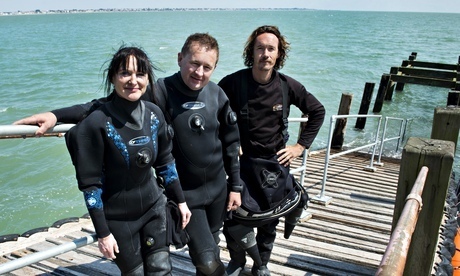
Excavating the 17th century London shipwreck: the diving team, Carol Ellis, Steve Ellis and Dan Pascoe, on Southend Pier, Essex. Photograph: Linda Nylind for the GuardianAn underwater rescue excavation is being mounted this summer by English Heritage to solve a 349-year-old mystery: how warship the London managed to blow itself up without firing a shot at the enemy off Southend.
Cotswold Archaeology and local divers hope to recover as much information as possible before the ship's splinted timbers finally disintegrate. Much of the wreck has been preserved within a deep layer of silt and mud in the on the bed of the Thames Estuary. But the wreck has been on the national inventory of heritage at risk since it was realised that timbers were being scoured bare and quickly destroyed by changing tidal patterns, including the dredging for the huge London Gateway port development.
In 1665 the explosion was a humiliating disaster. The London was blown in half, and sank almost instantly. A surprising number of the human remains recovered so far have proved to be female, suggesting that as well as the 350 crew, plus extra gunners for the newly mounted artillery, the ship was carrying many of their wives and sweethearts.
"It's a good question why there were so many women, and one on which I wouldn't care to speculate," archaeologist and diver Dan Pascoe said.
Only 24 men and one woman survived the disaster, clinging to the ornately carved stern which the archaeologists believe was left sticking vertically out of the shallow water.
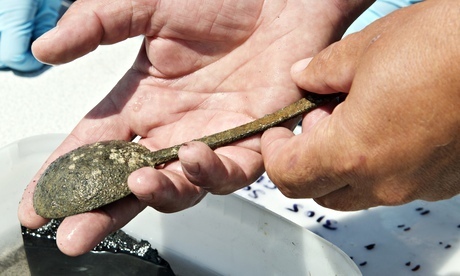 A spoon just brought into shore by the diving team after excavating the London shipwreck near Southend, Essex. Photograph: Linda Nylind for the Guardian A few hours later the London's new commander, Sir John Lawson, would have gone down with the ship: as it was, several of his children and other members of his family died. The London had been refitted at Chatham, and was sailing to Gravesend to collect him and become his flagship in the second Anglo-Dutch wars. The ship was carrying 300 barrels of gunpowder and it is believed that a 21 gun salute was being prepared. "Clearly there was some hiccup," Mark Dunkley, maritime archaeologist at English Heritage said.
A spoon just brought into shore by the diving team after excavating the London shipwreck near Southend, Essex. Photograph: Linda Nylind for the Guardian A few hours later the London's new commander, Sir John Lawson, would have gone down with the ship: as it was, several of his children and other members of his family died. The London had been refitted at Chatham, and was sailing to Gravesend to collect him and become his flagship in the second Anglo-Dutch wars. The ship was carrying 300 barrels of gunpowder and it is believed that a 21 gun salute was being prepared. "Clearly there was some hiccup," Mark Dunkley, maritime archaeologist at English Heritage said.
Apart from the mystery of its end, the wreck is of historic importance. The London was one of only three completed second-rate ships that were ordered for the English fleet between 1642 and 1660. With elaborate carved decoration, they were as much status symbols as weapons of war. The London is the only one that survives.
Archaeologists love sudden catastrophes. Most ships in history have become worn out and been stripped and broken up. A ship that sinks like the London, or the Mary Rose a century earlier, goes to the bottom with all their evidence of daily life: the cooking pots, beer tankards, candle sticks, cap badges, food barrels, rats and cats.
Diving conditions on the London are atrocious. They have an hour to work between tides, visibility is often down to inches, and the wreck lies so close to the shipping lane that they are buffeted by every passing vessel.
Working mainly by touch and the faint glimmer of their head torches, the divers are helping map the wreck and bring up finds every day: the most recent haul includes a pistol and musket shot, part of a weighing scales and spoons. The clay pipe and the tallow candles they also found "look very much like a smoking gun", archaeologist Steve Webster observed.
The finds are all being recorded and packed on the end of Southend pier as they come ashore, watched by curious sun bathers, strollers and local volunteers working with Southend Museum, where many will go on display.
Scores of the ship's guns must also still lie buried in the silt. Some were retrieved immediately after the wreck. The Royal Armouries at Fort Nelson has a fine French naval gun recovered in the 1960s, which must have been a captured prize, and is also displaying two bronze guns allegedly illegally removed from the wreck more recently. One of these was made in the 1590s by Peter Gill, a royal gun founder, and one bears the Commonwealth arms – together showing the variety of artillery in service on one of Charles II's ships.
Steven Ellis, a fishmonger from Leigh-on-Sea, hobby diver and passionate amateur historian, has been watching over the wreck for years. Local fishermen phone him if they spot anybody dubious near the wreck – one recent intruder proved to be a survey boat from Cotswold Archaeology.
Ellis dives most days, and hopes to be back when work resumes next summer. Among the objects he has recovered are two human skulls: "Sometimes when I get home, I just sit down in the kitchen and I can't get the thought of all those people, all those lives lost, out of my mind," he said.
http://www.theguardian.com/science/2014/jul/25/shipwreck-excavation-17th-century-london-southend

Maev Kennedy

Excavating the 17th century London shipwreck: the diving team, Carol Ellis, Steve Ellis and Dan Pascoe, on Southend Pier, Essex. Photograph: Linda Nylind for the GuardianAn underwater rescue excavation is being mounted this summer by English Heritage to solve a 349-year-old mystery: how warship the London managed to blow itself up without firing a shot at the enemy off Southend.
Cotswold Archaeology and local divers hope to recover as much information as possible before the ship's splinted timbers finally disintegrate. Much of the wreck has been preserved within a deep layer of silt and mud in the on the bed of the Thames Estuary. But the wreck has been on the national inventory of heritage at risk since it was realised that timbers were being scoured bare and quickly destroyed by changing tidal patterns, including the dredging for the huge London Gateway port development.
In 1665 the explosion was a humiliating disaster. The London was blown in half, and sank almost instantly. A surprising number of the human remains recovered so far have proved to be female, suggesting that as well as the 350 crew, plus extra gunners for the newly mounted artillery, the ship was carrying many of their wives and sweethearts.
"It's a good question why there were so many women, and one on which I wouldn't care to speculate," archaeologist and diver Dan Pascoe said.
Only 24 men and one woman survived the disaster, clinging to the ornately carved stern which the archaeologists believe was left sticking vertically out of the shallow water.
 A spoon just brought into shore by the diving team after excavating the London shipwreck near Southend, Essex. Photograph: Linda Nylind for the Guardian A few hours later the London's new commander, Sir John Lawson, would have gone down with the ship: as it was, several of his children and other members of his family died. The London had been refitted at Chatham, and was sailing to Gravesend to collect him and become his flagship in the second Anglo-Dutch wars. The ship was carrying 300 barrels of gunpowder and it is believed that a 21 gun salute was being prepared. "Clearly there was some hiccup," Mark Dunkley, maritime archaeologist at English Heritage said.
A spoon just brought into shore by the diving team after excavating the London shipwreck near Southend, Essex. Photograph: Linda Nylind for the Guardian A few hours later the London's new commander, Sir John Lawson, would have gone down with the ship: as it was, several of his children and other members of his family died. The London had been refitted at Chatham, and was sailing to Gravesend to collect him and become his flagship in the second Anglo-Dutch wars. The ship was carrying 300 barrels of gunpowder and it is believed that a 21 gun salute was being prepared. "Clearly there was some hiccup," Mark Dunkley, maritime archaeologist at English Heritage said.Apart from the mystery of its end, the wreck is of historic importance. The London was one of only three completed second-rate ships that were ordered for the English fleet between 1642 and 1660. With elaborate carved decoration, they were as much status symbols as weapons of war. The London is the only one that survives.
Archaeologists love sudden catastrophes. Most ships in history have become worn out and been stripped and broken up. A ship that sinks like the London, or the Mary Rose a century earlier, goes to the bottom with all their evidence of daily life: the cooking pots, beer tankards, candle sticks, cap badges, food barrels, rats and cats.
Diving conditions on the London are atrocious. They have an hour to work between tides, visibility is often down to inches, and the wreck lies so close to the shipping lane that they are buffeted by every passing vessel.
Working mainly by touch and the faint glimmer of their head torches, the divers are helping map the wreck and bring up finds every day: the most recent haul includes a pistol and musket shot, part of a weighing scales and spoons. The clay pipe and the tallow candles they also found "look very much like a smoking gun", archaeologist Steve Webster observed.
The finds are all being recorded and packed on the end of Southend pier as they come ashore, watched by curious sun bathers, strollers and local volunteers working with Southend Museum, where many will go on display.
Scores of the ship's guns must also still lie buried in the silt. Some were retrieved immediately after the wreck. The Royal Armouries at Fort Nelson has a fine French naval gun recovered in the 1960s, which must have been a captured prize, and is also displaying two bronze guns allegedly illegally removed from the wreck more recently. One of these was made in the 1590s by Peter Gill, a royal gun founder, and one bears the Commonwealth arms – together showing the variety of artillery in service on one of Charles II's ships.
Steven Ellis, a fishmonger from Leigh-on-Sea, hobby diver and passionate amateur historian, has been watching over the wreck for years. Local fishermen phone him if they spot anybody dubious near the wreck – one recent intruder proved to be a survey boat from Cotswold Archaeology.
Ellis dives most days, and hopes to be back when work resumes next summer. Among the objects he has recovered are two human skulls: "Sometimes when I get home, I just sit down in the kitchen and I can't get the thought of all those people, all those lives lost, out of my mind," he said.
http://www.theguardian.com/science/2014/jul/25/shipwreck-excavation-17th-century-london-southend

Published on July 30, 2014 13:30
Archaeologist happens upon Roman bone fragments – at the end of his road
Mike Heyworth says discovery in trench dug in York by utilities company demonstrates 'black holes' in archaeological planning
Maev Kennedy
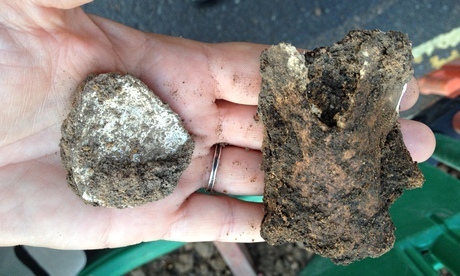
Mike Heyworth with the bone fragments found in a mound of excavated soil.Mike Heyworth, president of the Council for British Archaeology, was trudging home after a long, hot day in the office when he was startled to find fragments of Roman bone and pottery lying on a heap of soil at the end of his road.
The trench dug by a utilities company in York, which had sliced through an ancient cemetery, was on the corner of a residential street near the city's racecourse.
But it was also just across the road from a site that made headlines worldwide:, a pit under suburban back gardens where more than 80 skeletons of young gladiators – including one with bite marks from a lion, and decapitated skulls with the marks of hammer blows – were excavated.
The fragments of leg bone, and a jaw with teeth, that Heyworth happened upon may be a less sensational discovery. But he was astonished that nobody in the local authority had realised the sensitivity of the site – particularly in an area where Roman remains are often found close to the surface.
"Permission had been obtained from the council by the utility company to excavate the trench but apparently no condition was made to have an archaeologist present on site. When a known archaeological site is disturbed by any sort of development, it is vital that archaeologists can monitor the work and make a record of anything that is found," he said.
Heyworth says the incident shows up the "black holes" that are appearing in local authority archaeology services, with planners taking decisions without any specialist advice.
He notified both the police to inform them that human remains had been discovered and the local authority, and work has now been suspended while an archaeologist investigates the site
http://www.theguardian.com/science/2014/jul/27/archaeologist-roman-bone-fragments-york
Maev Kennedy

Mike Heyworth with the bone fragments found in a mound of excavated soil.Mike Heyworth, president of the Council for British Archaeology, was trudging home after a long, hot day in the office when he was startled to find fragments of Roman bone and pottery lying on a heap of soil at the end of his road.
The trench dug by a utilities company in York, which had sliced through an ancient cemetery, was on the corner of a residential street near the city's racecourse.
But it was also just across the road from a site that made headlines worldwide:, a pit under suburban back gardens where more than 80 skeletons of young gladiators – including one with bite marks from a lion, and decapitated skulls with the marks of hammer blows – were excavated.
The fragments of leg bone, and a jaw with teeth, that Heyworth happened upon may be a less sensational discovery. But he was astonished that nobody in the local authority had realised the sensitivity of the site – particularly in an area where Roman remains are often found close to the surface.
"Permission had been obtained from the council by the utility company to excavate the trench but apparently no condition was made to have an archaeologist present on site. When a known archaeological site is disturbed by any sort of development, it is vital that archaeologists can monitor the work and make a record of anything that is found," he said.
Heyworth says the incident shows up the "black holes" that are appearing in local authority archaeology services, with planners taking decisions without any specialist advice.
He notified both the police to inform them that human remains had been discovered and the local authority, and work has now been suspended while an archaeologist investigates the site
http://www.theguardian.com/science/2014/jul/27/archaeologist-roman-bone-fragments-york

Published on July 30, 2014 13:25



